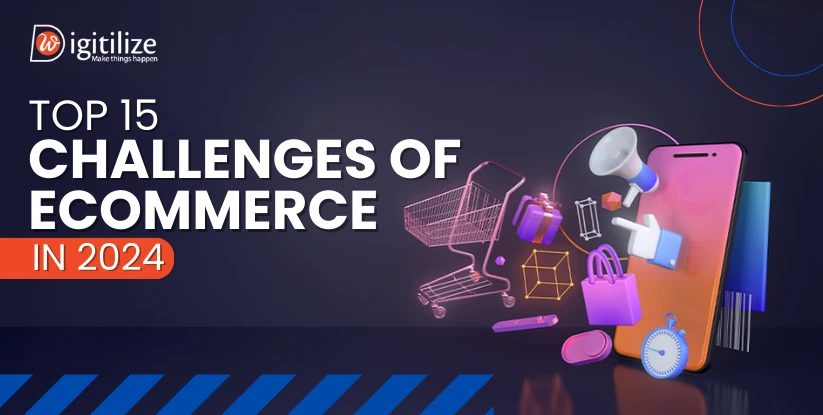Top 15 challenges of ecommerce in 2024

The ecommerce industry is enormous and dynamic. According to early predictions, this thriving sector will see even more innovation and growth in 2024. So, it is crucial to discuss the top 15 challenges of ecommerce in 2024. The greatest way to reach the global market is through ecommerce, where retail sales are to reach 8.1 trillion by 2026, offering businesses enormous development potential. In today’s piece, we’ll examine the potential, issues, and trends that experts believe will impact ecommerce in 2024 to prepare you for the anticipated changes for this year.
From a commercial perspective, this has led to heightened rivalry among e-commerce platforms where vendors offer their goods and services in order to access a larger market. Consequently, ecommerce companies are searching for ecommerce marketplace services more and more. In order to assist you in identifying ecommerce problems and solutions, we have developed this extensive blog devoted to dissecting the intricacies.
What is an ecommerce?
The trading or exchange of products and services using online platforms on the internet is referred to as ecommerce or electronic commerce. 2.14 billion individuals are thought to buy products and services online globally. A staggering 200 million Prime subscribers were also found to be making online purchases through Amazon shops. Because ecommerce offers so many opportunities, small businesses may use it to market their goods on a global scale and connect with potential clients.One of the biggest obstacles to B2C ecommerce in the modern retail landscape is attracting customers’ attention and persuading them to make purchases from online retailers. However, creating captivating visual content is a successful strategy for ecommerce success. Well-known vendors recognize this, and one of their most potent tools for ecommerce is a high-quality product image. 90% of buyers are seem to like product pictures.
The Greatest Ecommerce Problems of 2024 and Their Fixes

The kind and size of business they operate determines the different obstacles faced by the ecommerce industry. We can determine the difficulties faced by two large ecommerce businesses and SMBs. Let’s investigate these ecommerce issues for 2024.
-
Cybersecurity and data
Keep yourself informed and engaged. Make sure your data is backed up. Additionally, you may deploy security plugins to your websites to guard against hacking and information theft of any type. Consequently, this will lessen the possibility of identity theft when you shop online.
-
Enchanting the ideal client
Because digital marketers can more quickly locate and target your ideal client, they are now prefer over traditional marketers. Your items can appear to the correct customers with the proper research and analysis.
-
Customer loyalty
Here are a few different strategies for keeping customers. To begin with, it is crucial to offer outstanding customer service. Even when a consumer receives an excellent product, their pleasure really soars when they receive outstanding customer service. Second, it’s critical to stay in touch with customers via their chosen channel—be it blog posts, SMS, or email. Finding the best channel of communication for your particular client is crucial.
-
Cost and Delivery
Even while shipping expenses are unavoidable for eCommerce businesses, you should constantly try to discover solutions that will satisfy your target audience. Would delivery be less expensive with a subscription? Would they pay less for shipping at a particular period of the month? Or does a dependable carrier have a less expensive plan? Make careful to investigate and identify the greatest option for your customers.
-
Transnational ecommerce

Since eCommerce websites must interact with clients across national and language barriers, they can grow stagnant. When using a website, customers who don’t speak the predominant language sometimes want shops to offer a more user-friendly experience in their native tongue. Additionally, consumers may be deterred from making cross-border transactions by differences in pricing, tax rates, and other considerations. Thus, one of the major difficulties among the top 15 challenges of ecommerce in 2024.
It is necessary to have a multilingual website so users may simply navigate in their native tongue. Using technology to enable correct product taxes and smooth currency translation would also significantly boost growth.
-
Utilising omnichannel
-
Logistics
Obtain total control over your whole supply chain. Accurate inventory tracking and a clear communication system are made possible by supply chain visibility, which also keeps you updated on a variety of supply chain-related topics. Even though solving this eCommerce problem would take time and effort, it is still very important.
-
Handling Requests for Credit Lines
It has demonstrates that credit lines raise reorders by raising the average order size. With the help of B2B ecommerce website development services, the B2B marketplace may put in place an algorithm that verifies the buyer’s legitimacy and grants them a grace period.
-
Taking on Manufacturers and Retailers in Competition
Recognise the things they desire from a certain seller and maintain enough supply of those items to satisfy their demands. In order to provide your clients with a range of responses when they pose a query, teach your best salespeople to find weaknesses in any product.
-
SEO and Conversion Rate

Following SEO guidelines is essential for a business to be successful while operating online. You need to be present both online and offline to set yourself apart from other companies. It is possible to turn website visitors into customers with effective search engine marketing techniques. Increasing organic income is difficult, but increasing conversion rates is much more difficult.
To optimise your website, use relevant keywords in addition to other standard SEO techniques. Produce engaging content to entice visitors to stay on your website longer—getting them to spend is a major goal! Using customer advocacy and brand ambassadors, you may further tap into the power of satisfied consumers to boost sales.
-
The necessity of updating sales strategies
Make your goods available on popular online stores like Amazon and eBay. You may pitch and market your goods quite easily because most ecommerce companies already have a large customer base. By employing customer journey data, eCommerce can detect and link visitors to different websites thanks to visitor segmentation.
-
Client requirements
It is crucial to have a thorough awareness of current web design trends to handle this problem for your ecommerce endeavour. Thus, one of the major difficulties among the top 15 challenges of ecommerce in 2024. A thorough analysis of current patterns will assist you in determining the adjustments your company needs to make and will guide the implementation process.
-
Globalisation

Large ecommerce companies have particular challenges when they expand into foreign markets. Thus, it takes careful planning, market research, and customised methods to adjust to various rules, cultural variances, and client preferences.
To comprehend the cultural, legal, and economic subtleties of the global target markets, do in-depth market research. Therefore, modify your product lineup, advertising copy, and user interface to suit the tastes and requirements of each market.
-
Extra Fees Could be Applied
Always include the entire price list. Not just during the checkout process, but also throughout the procedure itself, indicate the delivery cost. It is not feasible to be billed. It’s quite simple. Naturally, if you sell to consumers abroad, regional considerations may come into play, and you should adjust delivery and customs fees appropriately.
-
The Difficulties of Returning & Refunding Items
Consumers are unhappy with the service they now receive and place a high value on hassle-free returns and exchanges, which suggests a big potential for businesses. You find it difficult to overlook generous refund and return procedures. But a well-thought-out policy with clear communication is attainable.
Collaborating with top-tier industry solution providers expands your eCommerce business’s market penetration and improves basket conversion rates. Consult with DigitilizeWeb’s professionals to identify the best ecommerce solutions and get beyond even the most difficult obstacles! For more follow us on LinkedIn.
FAQ
Frequently Asked Questions
By providing services like international rapid shipping, managing the paperwork and clearance procedures for customs, and working with customs brokers to manage intricate rules, shipping companies simplify international shipment.
Utilizing algorithms to verify buyer legitimacy and grant repayment periods based on credit history can help ecommerce platforms manage credit lines for B2B transactions.
Understanding customer preferences and maintaining sufficient supply of desired items can help ecommerce businesses compete effectively with manufacturers and retailers.
Employing relevant keywords, producing engaging content, and leveraging customer advocacy and brand ambassadors are effective strategies for optimizing SEO and conversion rates.
Keeping abreast of current web design trends and conducting thorough analysis of customer preferences can help ecommerce businesses meet evolving client requirements effectively.
By enabling companies to sell goods over a variety of channels and provide information to maximise consumer interactions across those channels, omnichannel strategies may boost total revenue.

